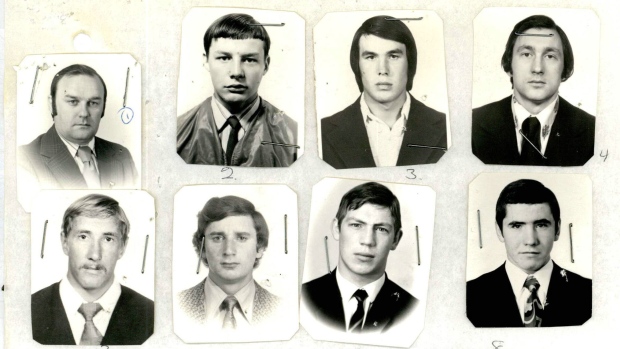Sep 12, 2016
Government releases cache of 'secret' 1976 Canada Cup documents
Library and Archives Canada has disclosed several hundred pages of documents related to security and planning issues in advance of the first Canada Cup.

Call it a Canada Cup mystery solved.
For years the Hockey Hall of Fame displayed a sculpture designed to commemorate the inaugural Canada Cup, played in September of 1976.
The relief sculpture, which went into storage in September 2015 because of renovations at the hall, features images of the heads of hockey players representing each of the six countries that participated in the event – Canada, the Soviet Union, Finland, Czechoslovakia, Sweden and the United States.
The hall has described the 25-pound sculpture as a gift to Hockey Canada by Russian hockey officials. The artist was unknown, according to a caption on the sculpture.
Not anymore.
Library and Archives Canada, in response to a request under the Access to Information Act, has disclosed several hundred pages of documents related to security and planning issues in advance of the first Canada Cup.
The documents, released some 40 years after the tournament, include briefings from the Canadian embassy in Moscow about the politics of international hockey at the time, and correspondence about travel visas for Soviet bloc hockey players, coaches and support staff.
One of the documents, released in August by Library and Archives Canada, reveals the sculpture arrived one day in the summer of 1976 at the Canadian embassy in Moscow.
According to an Aug. 4, 1976, message transmitted from embassy staff to the Canadian foreign affairs ministry in Ottawa, the sculpture was a gift from a Latvian artist.
“Have received at Emb by Post Copper bas relief sculpture from Riga artist by name of Karouch Akopian,” the message reads. “Bas-relief made in honour of CDA Cup tournament depicts hockey players (heads) representing each of six teams participating in tournament framed between 2 hockey sticks. Also top left-and corner has maple leaf. Sculpture is typical of work of ‘official’ Soviet artists. Artist has asked that sculpture be given to Alan Eagleson. Please advise disposition.”
Eagleson, the first executive director of the NHL Players' Association, helped to conceive the 1976 Canada Cup after rising to prominence for his work organizing the 1972 Summit Series between the Soviets and Canada.
Negotiations to stage the tournament began in 1974, when World Hockey Association players faced off in an eight-game tournament against a Soviet team. The 1976 Canada Cup was held in five Canadian cities and Philadelphia. Canada won a best-of-three final over Czechoslovakia.
Many of the newly disclosed documents are labelled “confidential” and “secret.” Some details remain redacted.

In June 1975, a cable labelled “restricted” from a Canadian embassy official in Moscow to the foreign ministry in Ottawa explained that Canadian diplomats had raised the possibility of a 1976 tournament with the Russian government.
“I underlined that CDA was attaching political importance to this hockey series,” wrote a Canadian diplomat named Ford.
Another memo, sent July 31, 1975, and labelled “restricted,” detailed how a refusal by the Toronto Maple Leafs to play Soviet teams that year might impact the Canada Cup the following year.
“The Russians and the NHL seem to be coming closer together on plans for a 1975 club team series, although the agreement is apparently not definite,” says the memo, signed by A.B. Roger. “The Russians had wanted to play at least three of the eight games proposed in Canada, but Vancouver is too far off and Toronto, according to [then team vice-president] King Clancy, have opted out for this year because their team is as yet too inexperienced to commit against a top Soviet formation.
“That leaves Montreal and seven American teams. This may not please the Russians particularly, as they seemed anxious to be seen to play against Canadians in Canada, but there appears to be little other choice. The circumstance also may weaken the leverage available to the organizers of the 1976 tournament inasmuch as Canadian direct involvement is substantially reduced and in the past the Montreal Canadiens have been quite unresponsive to outside pressure of any sort.”
Throughout the two-week Canada Cup, Canadian embassy officials in Moscow provided details to Ottawa of Soviet news coverage of the event.
On Sept. 16, 1976, Russian news agency TASS quoted Russian coach Victor Tikhonov saying “most games passed in uncompromising struggle from the beginning to end. To win in such competitions players must display all their skills and courage, and they must also have much experience of top-class international competitions.”
“The netminder [Vladislav] Tretiak was such a player on the Soviet team,” Tikhonov said. “It is even difficult to say how many fantastic saves he made…. There are many outstanding players on the Canadian team. Bobby Orr performed in his first international games as a veteran master and he demonstrated a marvellous understanding of hockey. He is selfless in the defence, excellently passes and his shots at the goal are both powerful and accurate.”
Tikhonov, whose team lost to Canada in the tournament’s semi-final, told TASS that Canadas’s goalie Rogie Vachon “is superior to Ken Dryden, Tony Esposito and Gerry Cheevers. [Vachon] plays without mistakes in the cage and when intercepting the puck.”
Perhaps it shouldn’t come as a surprise that Tikhonov also offered a review of the Canada Cup referees.
“The tournament would have been an even greater success had the officiating been more objective,” Tikhonov said. “In four games out of five, arbitrary action by referees left the Soviet team with three players against five opponents. … I think it is high time for European and North American referees to draw closer together in their interpretation of the rules.”

